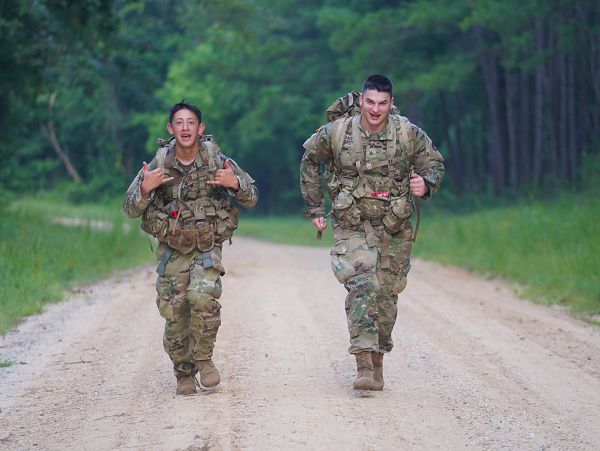
Fort Novosel, Alabama. (August 7, 2023): In this photo by Adam Sikes, Specialist Jason Riley, on the left, and Sergeant Jason Paglia appear in good spirits despite facing a grueling ruck march at Army Materiel Command's 2023 Best Squad Competition held here recently. Travelling long distances carrying a heavy rucksack, or “rucking,” is a practice as old as the American Army itself.
While the burdens carried by individual soldiers have changed over the years, the need for an efficient way for troops to transport weapons and equipment without bringing them to exhaustion has not changed. Today’s rucksack is essentially a large, rugged backpack whose name is derived from the German, “der rücken,” or “the back.” Every American soldier has endured a steep, seemingly never-ending incline, bent over, while carrying an 80-pound rucksack. What most troops failed to realize is the extensive research and development that has gone into this metal framed monster on their backs.
The first recorded instance of a warrior carrying a backpack was the famous “Otzi the Iceman,” a Copper age mummy encased in mountain ice for centuries that was discovered by a group of hikers in Italy. Otzi carried a bag along with his weapons and other gear in an animal skin pack supported by wooden stakes.
The forerunner of the modern backpack was designed by Henry Merriam In 1878 who received a patent for his “Knapsack” which included a metal frame that held the pack away from a soldier’s body.
During the Civil War, soldiers carried their gear in bundles built with sticks and canvas cloth which were a burden to carry and a constant source of irritation for Colonial troops. The advent of World War I brought the need for improved military backpacks and the “Haversack” was born. The Haversack was strapped onto the upper and lower back and held ammo, canteens, shovels, and other personal items.
In World War II, soldiers needed to carry much more weight including parts of crew-served weapons like machine guns, ammunition, and other heavy equipment. In Vietnam, the “Alice” backpack made its debut featuring multiple compartments that could be secured with metal straps.
Today’s Modular Lightweight Load-carrying Equipment (MOLLIE) backpack is standard issue for the troops. It has durable nylon straps for maximum comfort and is made of high tech super light material to lessen the burden on soldiers. All these innovations still require the toughness and tenacity of American soldiers and Marines willing to “ruck up” and defend their country.


